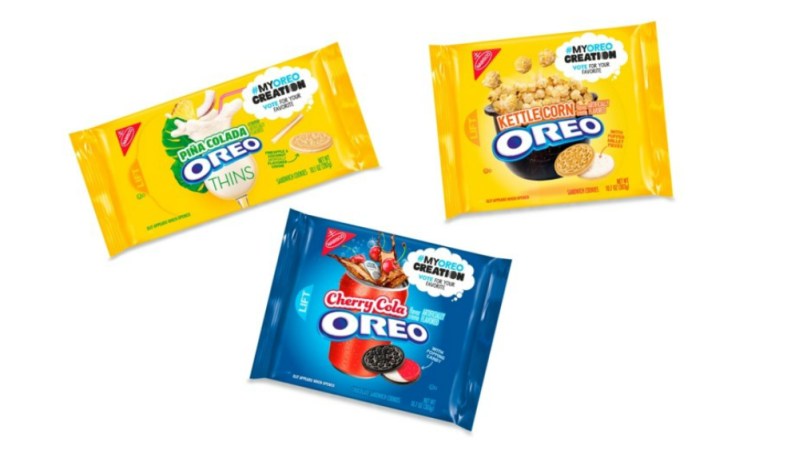
From time to time, due to slumping sales or the company equivalent of a midlife crisis, companies decide that they need to change things up. For some (cough Coca Cola cough), they move to change a recipe which has proven over decades that it is successful. For others, it’s an attempt to look fresher, more modern. The Nabisco company, with their various brands and products, is no stranger to this approac.
Oreos — the reason you’ve clicked on this article — are the perfect example. The chocolate sandwich cookie, which was originally produced in 1912 to compete with Hydrox cookies, remained largely unchanged for most of the last century. Yes, different variations on the Oreo were introduced — who hasn’t indulged in a couple of Double Stufs our housed a bag of Oreo Minis from time to time? — but the changing of the key flavors of the Oreo wasn’t the focus. The dalliances into new Oreo flavors and colors on a seasonal basis were fun and welcomed, especially as a child. You could only get the orange-colored Oreos around Halloween, et cetera.

The 2000s though, marked a new(er) era for Oreos. Flavors started coming fast and loose. In total — and not counting any of the Oreo products that are not just two cookies with crème in the middle, such as Jell-O Oreo pudding, Fudge Covered Oreos, or anything similar — Nabisco has produced around 75 different Oreo flavors. Some were purely for promotional purposes, such as the Android Oreo, and some were only available in certain counties (the Orange Ice Cream Oreo, which was produced for Indonesia, Malaysia, Singapore, and Thailand).
It has to be pointed out that the majority of the flavors that Oreo has produced, conceptually at least, sound good. Take the three Oreo flavors that were released in January 2018: Chocolate Hazelnut Oreo, Spicy Hot Cinnamon Oreo, and “Hot Cocoa Oreo.” All of these sound like palatable chocolate sandwich cookie flavors because the flavors are chocolate-adjacent — hazelnut and cinnamon both go with chocolate normally.
But still. Seventy-five. There had to be a time where they just opened a dictionary to a random page, pointed to a word, and that was their new flavor:
“Octopus! Our new flavor is Octopus!”
“Bob, we can’t do octopus, no one will buy that. It’s 2016, our consumers are know better than that. Let’s do Octopus Ink!”
“Brilliant!”
Perhaps the dictionary method started to fail them, or perhaps the dictionary disappeared one day, leaving them quietly staring at each other, either way, it brings us to 2018 and the #MyOreoCreation contest that Nabisco is holding.
The three flavor finalists — Piña Colada, Kettle Corn, and Cherry Cola — were then produced and put on shelves for people to buy and vote on. These beat out suggestions such as coffee and doughnut (a promising concept considering the dunkability of the cookie), avocado (go home, hipsters), and unicorn (there’s a few layers to this one that we don’t have time to unpack). Consumers are allowed encouraged to go out, try the cookies, and vote on a winner. That winner will received a hefty chunk of change (though, if this article is to be believed — and it seems fairly legit — Nabisco itself is one of the entrants in the contest).
Here’s our taste test review of this new batch of Oreo flavors:
Cherry Cola

Pros: Bold move, in theory, to move away from cookie-adjacent flavors. Sure, cookies and soda is portrayed as the ultimate sugar-rush-when-the-parents-aren’t-around kind of snack, but is that really still a thing in 2018? Maybe it’s because I was raised on cookies and milk, but the thought of sweet carbonation mixing with sweet crème and soon-to-be-mushy cookie is wholly unappealing. But this is supposed to be about the pros of this cookie. The red dye used in the crème is very vibrant and reminiscent of cherries.
Cons: Have you ever left a Cherry Cola Slurpee in your car and returned to it the next day? That’s what these smell like. Right from the instant you pull back the packaging, you’re assaulted with a stale cola smell, overlaid by cherry, and topped with instant regret. This is not the worst part about this cookie abomination, though. That award goes to the popping candy that Oreo has put in the crème. The Oreo already has a crunchy part, two in fact — they’re called cookies. There is absolutely no need for that extra crunch. Drinking soda doesn’t make your throat sound like rain on a tin roof, neither should your soda-flavored cookie.
Try It For Yourself
Piña Colada

Pros: If you’re looking for the one that will impact your health the least, these are it (relatively, of course). The serving size for the Piña Colada Oreos is four cookies (compared to Cherry Cola and Kettle Corn, which are both two cookies per serving), which, in theory, allows you to eat double the amount at the same cost to your well-being. On the flavor side, the pineapple and coconut crème isn’t actually that terrible. It doesn’t taste like a real piña colada, but it’s not too overbearing, with pineapple leading the way, followed by creamy coconut. Another bonus is that there are no extras thrown into this one — a welcome reprieve considering that it isn’t a stretch to imagine the execs going, “Let’s throw sweetened shredded coconut in there, too!”
Cons: If you’re a fan of Bath and Body Works, this cookie is for you. The smell of the cookies is reminiscent of a piña colada-scented hand soap, so if you ever thought, “Man, I wish I could eat this soap,” now you can see what that experience would’ve been like. If that thought’s never crossed your mind, great! The only other qualm here is the thin cookie. Sure, it’s a bit crispier, but it’s hard not to feel robbed, knowing the bounty that comes from a good, wholesome normal Oreo cookie.
Try It For Yourself
Kettle Corn

Pros: The best thing the Kettle Corn Oreos have going for them is the overall flavor up until the aftertaste. Caramel up front, a hint of saltiness through the chew, then it all ends with what I imagine is a Paula Deen serving of butter, which lingers for a little longer than is acceptable (kind of like when your friend is the last person at the party and you love them and all but you want them to leave because you’re drunk and just want to go to bed with some Totino’s pizza rolls).
Cons: Two questions. As with the unicorn mentioned above, who ever thought, “I want kettle corn turned into a cookie”? Kettle corn is already a hand-held snack. Second, who — in the history of humanity — has ever said the words “I need more puffed millet in my life?” Exactly. Thankfully, on a texture level, the millet pieces don’t do much to interrupt the experience (unlike the pop rocks in the Cherry Cola flavor). They do, however, make the cookies look bad. If you look at a typical Oreo, the crème is one smooth ribbon holding the two cookies together. The puffed millet make these cookies look like someone attempted to make cookies at home but didn’t fully mix the frosting, leaving clumps of powdered sugar. One thing that came up during tasting is the issue of marketing. With many of the same flavors (and looking at current trends), this Oreo could’ve easily been packaged sans millet as Salted Caramel and maybe would’ve had a better shot. As Kettle Corn, though? Only time will tell.
Try It For Yourself
Our Favorite?
Piña colada. Sure, it’s a thinner cookie, but it’s by far the least overall offensive of the flavors. The lack of stuff put into the crème makes it an appealing, tropical cousin to the original Oreo. If Oreo flavors are your thing, great. You’re probably going to love all three (or at least two) of these equally. You do you. If it were up to us, we’d wait for a rebrand on the Kettle Corn and banish the Cherry Cola Oreos to hell (sending Pumpkin Spice Oreos with them).
Have you tried any of these flavors yet? What do you think?



